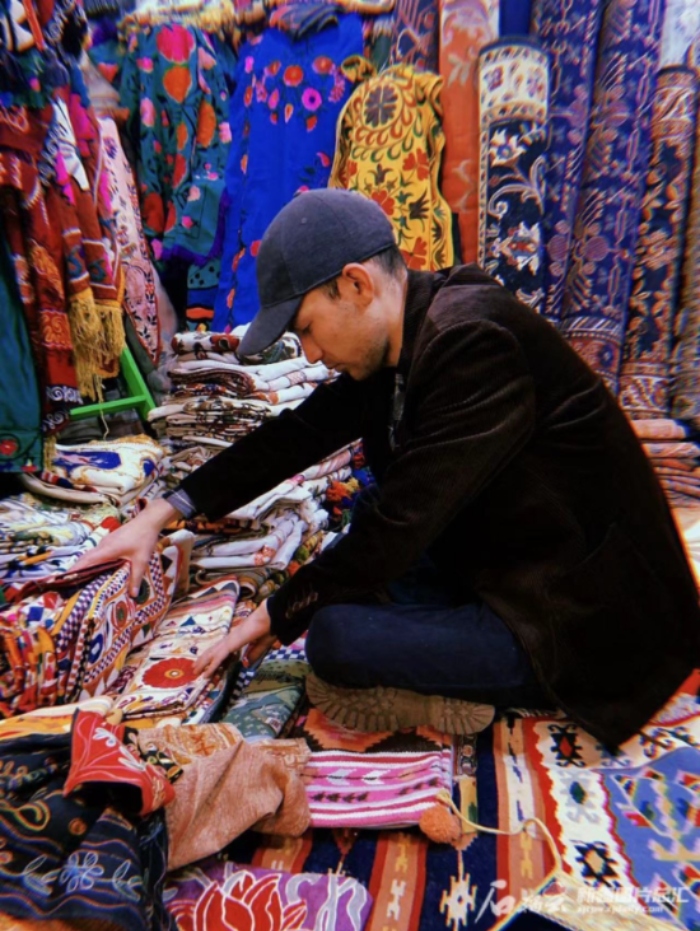
Photo taken on February 7, 2022 shows Mawlan Turak chooses fabrics at a fabric store. (Photo provided by Mawlan Turak)
Taking off her hoodies and jeans, a tourist from Shanghai called Ye Zining put on a resplendent and graceful Uygur traditional costume, as well as a flower hat and some accessories so as to take portraits in the Kashgar Ancient City scenic spot, acquiring the best experience. ‘When I stroll the street of the ancient city, I feel like a native to the place.’ said Ye Zining. All the clothes and accessories on her were hand-made by Mawlan Turak.
On February 8, 2022, at a little store named ‘Ru Mi Wen Chuang’, meaning obsession with cultural creative products, in the Kashgar Ancient City scenic spot, tourists entered the store on and on, indulging themselves in the exquisite clothes being displayed, while Mawlan Turak sat in front of the operation desk, absorbing himself in making braid accessories.
Mawlan Turak enters 28 this year, whose young body carries a heart of a craftsman. He opened the store after his returning to the hometown finishing university in 2018. In this small store covering an area of 30 square meters, on one hand, he carries on collecting traditional costumes and accessories from all over Xinjiang, which is an undertaking he set about doing since university; on the other hand, he devotes himself to the restoration and innovative transformation of the traditional clothing.

Photo shows the braid accessories hand-made by Mawlan Turak. (Photo provided by Mawlan Turak)
Braided ornaments are made of gold, silver or copper with different patterns, bells and chains, supplemented by gemstones, and then connected through traditional craftsmanship. Even for Mawlan, who has been exposed to handicraft since childhood, it takes half a day to make a braid. ‘If I love it, I won't feel tired. If I'm too busy during the day, I'll take the time to do some small handicrafts at night.’ Mawlan said.
His predilection and affection towards traditional costumes could be dated back to his childhood. ‘My mother was a dressmaker. While watching her working on the sewing machine, I would make some stuff by my own, or draw down the beautiful flower patterns I saw on the clothes. As I grew older, my obsession with the textures and patterns on the traditional clothing and color matching got stronger.’ said Mawlan Turak.
Collecting old photos, watching old movies, going to museums, looking for traditional costume styles in images, and consulting old tailors and jewelry craftsmen with rich experience on clothes-making... Since college, Mawlan has been devoted to restoring traditional clothes based on historical materials, ancient books, and old photos. ‘My mother has always encouraged me and worked with me to turn the design samples into finished products.’ Mawlan said.
A video titled ‘A Hundred Years of Beauty of Uygur Costumes’, which is popular on the internet, shows the century-old changes in Uygur women's clothing culture from 1910 to 2010. One of the main creators of the video is Mawlan. He and his mother used 5 months to restore and design most of the costumes in the video.
Today, in Mawlan's small store, there are more than 200 sets of traditional clothing on display, as well as matched handmade jewelries, and these are just a part of the clothing restored in cooperation by him and his mother. From 2018 to the present, more and more people have come into contact with and grown into traditional costumes through ‘Ru Mi Wen Chuang’, and some clothes will be sold soon after they are made.
Besides making traditional clothes by hand, Mawlan designed cultural creative products including pencil bags and cultural shirts with Xinjiang elements according to patterns on traditional clothing.
At the end of 2021, Mawlan's solo exhibition ‘Life Aesthetics in Southern Xinjiang’ was held at the Shanghai Theater Academy. Regarding the costumes he designed, some commented that Mawlan took inspiration of colors and patterns from jewelries and costumes handed down from the past, and made secondary creations to create costume art that not only inherited the traditional elements but also conformed to the aesthetics of modern people.
‘Traditional costume is a medium for the intuitive expression of ethnic culture. With the diversified development of world culture, people's pursuit of aesthetics is constantly being updated. I will use my perseverance and excellence to make traditional clothing more vigorous.’ Mawlan said.









